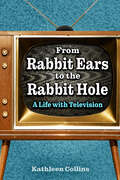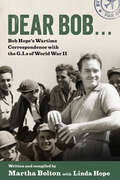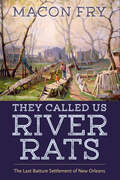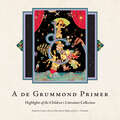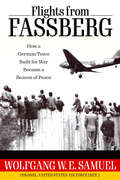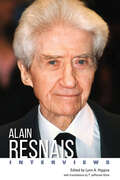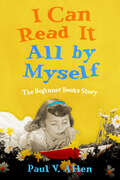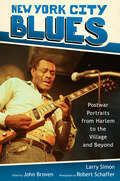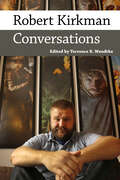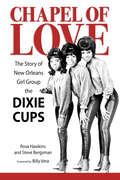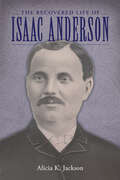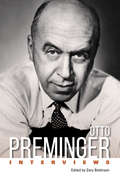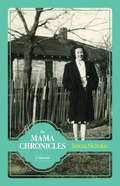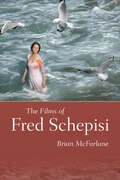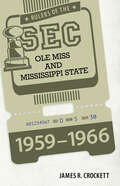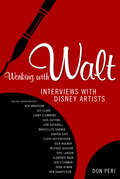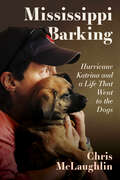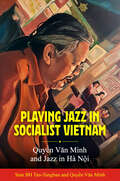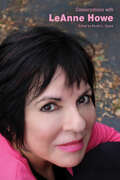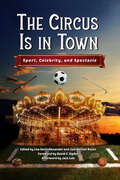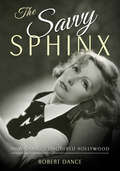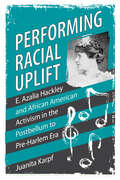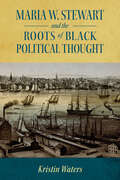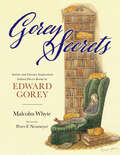- Table View
- List View
From Rabbit Ears to the Rabbit Hole: A Life with Television
by Kathleen CollinsFor the past several years, critics have been describing the present era as both “the end of television” and one of “peak TV,” referring to the unprecedented quality and volume and the waning of old technologies, formats, and habits. Television’s projections and reflections have significantly contributed to who we are individually and culturally. From Rabbit Ears to the Rabbit Hole: A Life with Television reveals the reflections of a TV scholar and fan analyzing how her life as a consumer of television has intersected with the cultural and technological evolution of the medium itself. In a narrative bridging television studies, memoir, and comic, literary nonfiction, Kathleen Collins takes readers alongside her from the 1960s through to the present, reminiscing and commiserating about some of what has transpired over the last five decades in the US, in media culture, and in what constitutes a shared cultural history. In a personal, critical, and entertaining meditation on her relationship with TV—as avid consumer and critic—she considers the concept and institution of TV as well as reminiscing about beloved, derided, or completely forgotten content. She describes the shifting role of TV in her life, in a progression that is far from unique, but rather representative of a largely collective experience. It affords a parallel coming of age, that of the author and her coprotagonist, television. By turns playful and serious, wry and poignant, it is a testament to the profound and positive effect TV can have on a life and, by extrapolation, on the culture.
Dear Bob: Bob Hope's Wartime Correspondence with the G.I.s of World War II
by Martha Bolton Linda HopeWinner of the 2021 Golden Scroll Awards for Memoir of the Year and Christian Market Book of the Year awarded by the Advanced Writers and Speakers AssociationFIRST PLACE WINNER IN THE MEMOIR CATEGORY OF THE 2022 SELAH AWARDSFor five decades, comedian, actor, singer, dancer, and entertainer Bob Hope (1903–2003) traveled the world performing before American and Allied troops and putting on morale-boosting USO shows. Dear Bob . . . : Bob Hope’s Wartime Correspondence with the G.I.s of World War II tells the story of Hope’s remarkable service to the fighting men and women of World War II, collecting personal letters, postcards, packages, and more sent back and forth among Hope and the troops and their loved ones back home. Soldiers, nurses, wives, and parents shared their innermost thoughts, swapped jokes, and commiserated with the “G.I.s’ best friend” about war, sacrifice, lonely days, and worrisome, silent nights. The Entertainer of the Century performed for millions of soldiers in person, in films, and over the radio. He visited them in the hospitals and became not just a pal but their link to home. This unforgettable collection of letters and images, many of which remained in Hope’s personal files throughout his life and now reside at the Library of Congress, capture a personal side of both writer and recipient in a very special and often-emotional way. This volume heralds the voices of those servicemen and women whom Hope entertained and who, it is clear, delighted and inspired him.
They Called Us River Rats: The Last Batture Settlement of New Orleans
by Macon FryThey Called Us River Rats: The Last Batture Settlement of New Orleans is the previously untold story of perhaps the oldest outsider settlement in America, an invisible community on the annually flooded shores of the Mississippi River. This community exists in the place between the normal high and low water line of the Mississippi River, a zone known in Louisiana as the batture. For the better part of two centuries, batture dwellers such as Macon Fry have raised shantyboats on stilts, built water-adapted homes, foraged, fished, and survived using the skills a river teaches. Until now the stories of this way of life have existed only in the memories of those who have lived here. Beginning in 2000, Fry set about recording the stories of all the old batture dwellers he could find: maritime workers, willow furniture makers, fishermen, artists, and river shrimpers. Along the way, Fry uncovered fascinating tales of fortune tellers, faith healers, and wild bird trappers who defiantly lived on the river. They Called Us River Rats also explores the troubled relationship between people inside the levees, the often-reviled batture folks, and the river itself. It traces the struggle between batture folks and city authorities, the commercial interests that claimed the river, and Louisiana’s most powerful politicians. These conflicts have ended in legal battles, displacement, incarceration, and even lynching. Today Fry is among the senior generation of “River Rats” living in a vestigial colony of twelve “camps” on New Orleans’s river batture, a fragment of a settlement that once stretched nearly six miles and numbered hundreds of homes. It is the last riparian settlement on the Lower Mississippi and a contrarian, independent life outside urban zoning, planning, and flood protection. This book is for everyone who ever felt the pull of the Mississippi River or saw its towering levees and wondered who could live on the other side.
A de Grummond Primer: Highlights of the Children's Literature Collection
by Carolyn J. Brown, Ellen Hunter Ruffin, and Eric L. TribunellaContributions by Ann Mulloy Ashmore, Rudine Sims Bishop, Ruth B. Bottigheimer, Jennifer Brannock, Carolyn J. Brown, Ramona Caponegro, Lorinda Cohoon, Carol Edmonston, Paige Gray, Laura Hakala, Andrew Haley, Wm John Hare, Dee Jones, Allison G. Kaplan, Megan Norcia, Nathalie op de Beeck, Amy Pattee, Deborah Pope, Ellen Hunter Ruffin, Anita Silvey, Danielle Bishop Stoulig, Roger Sutton, Deborah D. Taylor, Eric L. Tribunella, Alexandra Valint, and Laura E. Wasowicz During the 1960s, a dedicated library science professor named Lena de Grummond initiated a letter-writing campaign to children’s authors and illustrators requesting original manuscripts and artwork to share with her students. Now named after de Grummond, this archive at the University of Southern Mississippi has grown into one of the largest collections of historical and contemporary youth literature in North America with original contributions from more than 1,400 authors and illustrators, as well as over 185,000 volumes. The first book-length project on the collection, A de Grummond Primer: Highlights of the Children's Literature Collection provides a history of de Grummond’s work and an introduction to major topics in the field of children’s literature. With more than ninety full-color images, it highlights particular strengths of the archive, including extensive holdings of fairy tales, series books, nineteenth-century periodicals, Golden Age illustrated books, Mississippi and southern children’s literature, nonfiction, African American children’s literature, contemporary children’s and young adult authors and illustrators, and more. The book includes contributions from literature and information science scholars, historians, librarians, and archivists—all noted experts on children’s literature—and points to the exciting research possibilities of the archive.De Grummond could not have realized when she wrote to luminaries like H. A. and Margret Rey, Berta and Elmer Hader, Madeleine L’Engle, J. R. R. Tolkien, Lois Lenski, Garth Williams, and others that their correspondence and contributions would form the foundation for this extraordinary trove now visited by scholars from around the world. Such major authors and illustrators as Ezra Jack Keats, Richard Peck, Rosemary Wells, Angela Johnson, and John Green continued to donate content. In addition, curators, past and present, have acquired both historical and contemporary volumes of literature and criticism.
Flights from Fassberg: How a German Town Built for War Became a Beacon of Peace (Willie Morris Books in Memoir and Biography)
by Colonel Wolfgang W. SamuelWolfgang W. E. Samuel, Colonel, US Air Force (Ret.), interweaves his story and that of his family with the larger history of World War II and the postwar world through a moving recollection and exploration of Fassberg, a small town in Germany few have heard of and fewer remember. Created in 1933 by the Hitler regime to train German aircrews, Fassberg hosted Samuel’s father in 1944–45 as an officer in the German air force. As fate and Germany's collapse chased young Wolfgang, Fassberg later became his home as a postwar refugee, frightened, traumatized, hungry, and cold.Built for war, Fassberg made its next mark as a harbinger of the new Cold War, serving as one of the operating bases for Allied aircraft during the Berlin Airlift in 1948. With the end of the Berlin Crisis, the airbase and town faced a dire future. When the Royal Air Force declared the airbase surplus to its needs, it also signed the place's death warrant, yet increasing Cold War tensions salvaged both base and town. Fassberg transformed again, this time into a forward operating base for NATO aircraft, including a fighter flown by Samuel's son.Both personal revelation and world history, replete with tales from pilots, mechanics, and all those whose lives intersected there, Flights from Fassberg provides context to the Berlin Airlift and its strategic impact, the development of NATO, and the establishment of the West German nation. The little town built for war survived to serve as a refuge for a lasting peace.
Conversations with Steve Erickson (Literary Conversations Series)
by Matthew Luter and Mike MileyMuch like his novels, Steve Erickson (b. 1950) exists on the periphery of our perception, a shadow figure lurking on the margins, threatening to break through, but never fully emerging. Despite receiving prestigious honors, Erickson has remained a subterranean literary figure, receiving effusive praise from his fans, befuddled or cautious assessments from reviewers, and scant scholarly attention. Erickson’s obscurity comes in part from the difficulty of categorizing his work within current trends in fiction, and in part from the wide variety of concerns that populate his writing: literature, music, film, politics, history, time, and his fascination with his home city of Los Angeles. His dream-fueled blend of European modernism, American pulp, and paranoid late-century postmodernism makes him essential to an appreciation of the last forty years of American fiction but difficult to classify neatly within that same realm. He is at once thoroughly of his time and distinctly outside it. In these twenty-four interviews Erickson clarifies how his aesthetic and political visions are inextricable from each other. He diagnoses the American condition since World War II, only to reveal that America’s triumphs and failures have been consistent since its inception—and that he presciently described decades ago certain features of our present. Additionally, the interviews expose the remarkable consistency of Erickson’s vision over time while simultaneously capturing the new threads that appear in his later fiction as they emerge in his thought. Conversations with Steve Erickson will deepen readers’ understanding of how Erickson’s books work—and why this utterly singular writer deserves greater attention.
Alain Resnais: Interviews (Conversations with Filmmakers Series)
by T. Jefferson KlineAmong the most innovative and influential filmmakers of the twentieth century, Alain Resnais (1922–2014) did not originally set out to become a director. He trained as an actor and film editor and, during the sixty-eight years of his working life, delved into virtually every corner of filmmaking, working at one time or another as screenwriter, assistant director, camera operator and cinematographer, special effects coordinator, technical consultant, and even author of source material. From such award-winning documentaries as Van Gogh and Night and Fog to the groundbreaking dramas Hiroshima mon amour, Last Year at Marienbad, and Muriel, Resnais’s films experiment with such themes as consciousness, memory, and the imagination. Distinguishing himself from associations with the French New Wave movement, Resnais considered his films to be “anti-illusionist,” never allowing his spectators to forget they were watching a work of art. In Alain Resnais: Interviews, editor Lynn A. Higgins collects twenty-one interviews with the filmmaker, twelve of which are translated into English for the first time. Spanning his entire career from his early short subjects to his final feature film, the volume highlights Resnais’s creative strategies and principles, illuminates his place in world cinema history, and situates his work relative to the New Wave, American film, and experimental filmmaking more broadly. Like his films, the interviews collected here reveal a creator who is at once an intellectual, a philosopher, an entertainer, a craftsman, and an artist.
I Can Read It All by Myself: The Beginner Books Story
by Paul V. AllenIn the late 1950s, Ted Geisel took on the challenge of creating a book using only 250 unique first-grade words, something that aspiring readers would have both the ability and the desire to read. The result was an unlikely children’s classic, The Cat in the Hat. But Geisel didn’t stop there. Using The Cat in the Hat as a template, he teamed with Helen Geisel and Phyllis Cerf to create Beginner Books, a whole new category of readers that combined research-based literacy practices with the logical insanity of Dr. Seuss. The books were an enormous success, giving the world such authors and illustrators as P. D. Eastman, Roy McKie, and Stan and Jan Berenstain, and beloved bestsellers such as Are You My Mother?; Go, Dog. Go!; Put Me in the Zoo; and Green Eggs and Ham. The story of Beginner Books—and Ted Geisel’s role as “president, policymaker, and editor” of the line for thirty years—has been told briefly in various biographies of Dr. Seuss, but I Can Read It All by Myself: The Beginner Books Story presents it in full detail for the first time. Drawn from archival research and dozens of brand-new interviews, I Can Read It All by Myself explores the origins, philosophies, and operations of Beginner Books from The Cat in the Hat in 1957 to 2019’s A Skunk in My Bunk, and reveals the often-fascinating lives of the writers and illustrators who created them.
New York City Blues: Postwar Portraits from Harlem to the Village and Beyond (American Made Music Series)
by Larry SimonA first-ever book on the subject, New York City Blues: Postwar Portraits from Harlem to the Village and Beyond offers a deep dive into the blues venues and performers in the city from the 1940s through the 1990s. Interviews in this volume bring the reader behind the scenes of the daily and performing lives of working musicians, songwriters, and producers. The interviewers capture their voices — many sadly deceased — and reveal the changes in styles, the connections between performers, and the evolution of New York blues. New York City Blues is an oral history conveyed through the words of the performers themselves and through the photographs of Robert Schaffer, supplemented by the input of Val Wilmer, Paul Harris, and Richard Tapp. The book also features the work of award-winning author and blues scholar John Broven. Along with writing a history of New York blues for the introduction, Broven contributes interviews with Rose Marie McCoy, “Doc” Pomus, Billy Butler, and Billy Bland. Some of the artists interviewed by Larry Simon include Paul Oscher, John Hammond Jr., Rosco Gordon, Larry Dale, Bob Gaddy, “Wild” Jimmy Spruill, and Bobby Robinson. Also featured are over 160 photographs, including those by respected photographers Anton Mikofsky, Wilmer, and Harris, that provide a vivid visual history of the music and the times from Harlem to Greenwich Village and neighboring areas. New York City Blues delivers a strong sense of the major personalities and places such as Harlem’s Apollo Theatre, the history, and an in-depth introduction to the rich variety, sounds, and styles that made up the often-overlooked New York City blues scene.
Robert Kirkman: Conversations (Conversations with Comic Artists Series)
by Terrence R. WandtkeRobert Kirkman (b. 1978) is probably best known as the creator of The Walking Dead. The comic book and its television adaptation have reinvented the zombie horror story, transforming it from cult curiosity and parody to mainstream popularity and critical acclaim. In some ways, this would be enough to justify this career-spanning collection of interviews. Yet Kirkman represents much more than this single comic book title.Kirkman’s story is a fanboy’s dream that begins with him financing his irreverent, independent comic book Battle Pope with credit cards. After writing major titles with Marvel comics (Spider-Man, Captain America, and X-Men), Kirkman rejected companies like DC and Marvel and publicly advocated for creator ownership as the future of the comics industry. As a partner at Image, Kirkman wrote not only The Walking Dead but also Invincible, a radical reinvention of the superhero genre. Robert Kirkman: Conversations gives insight to his journey and explores technique, creativity, collaboration, and the business of comics as a multimedia phenomenon. For instance, while continuing to write genre-based comics in titles like Outcast and Oblivion Song, Kirkman explains his writerly bias for complex characters over traditional plot development. As a fan-turned-creator, Kirkman reveals a creator’s complex relationship with fans in a comic-con era that breaks down the consumer/producer dichotomy. And after rejecting company-ownership practices, Kirkman articulates a vision of the creator-ownership model and his goal of organic creativity at Skybound, his multimedia company. While Stan Lee was the most prominent comic book everyman of the previous era of comics production, Kirkman is the most prominent comic book everyman of this dynamic, evolving new era.
Chapel of Love: The Story of New Orleans Girl Group the Dixie Cups (American Made Music Series)
by Rosa Hawkins Steve BergsmanIn 1963, sisters Barbara Ann and Rosa Hawkins and their cousin Joan Marie Johnson traveled from the segregated South to New York City under the auspices of their manager, former pop singer Joe Jones. With their wonderful harmonies, they were an immediate success. To this day, the Dixie Cups’ greatest hit, “Chapel of Love,” is considered one of the best songs of the past sixty years. The Dixie Cups seemed to have the world on a string. Their songs were lively and popular, singing on such topics as love, romance, and Mardi Gras, including the classic “Iko Iko.” Behind the stage curtain, however, their real-life story was one of cruel exploitation by their manager, who continued to harass the women long after they finally broke away from his thievery and assault. Of the three young women, no one suffered more than the youngest, Rosa Hawkins, who was barely out of high school when the New Orleans teens were discovered and relocated to New York City. At the peak of their success, Rosa was a naïve songstress entrapped in a world of abuse and manipulation. Chapel of Love: The Story of New Orleans Girl Group the Dixie Cups explores the ups and downs of one of the most successful girl groups of the early 1960s. Telling their story for the first time, in their own words, Chapel of Love reintroduces the Louisiana Music Hall of Famers to a new audience.
The Recovered Life of Isaac Anderson
by Alicia K. JacksonOwned by his father, Isaac Harold Anderson (1835–1906) was born a slave but went on to become a wealthy businessman, grocer, politician, publisher, and religious leader in the African American community in the state of Georgia. Elected to the state senate, Anderson replaced his white father there, and later shepherded his people as a founding member and leader of the Colored Methodist Episcopal church. He helped support the establishment of Lane College in Jackson, Tennessee, where he subsequently served as vice president. Anderson was instrumental in helping freed people leave Georgia for the security of progressive safe havens with significantly large Black communities in northern Mississippi and Arkansas. Eventually under threat to his life, Anderson made his own exodus to Arkansas, and then later still, to Holly Springs, Mississippi, where a vibrant Black community thrived. Much of Anderson’s unique story has been lost to history—until now. In The Recovered Life of Isaac Anderson, author Alicia K. Jackson presents a biography of Anderson and in it a microhistory of Black religious life and politics after emancipation. A work of recovery, the volume captures the life of a shepherd to his journeying people, and of a college pioneer, a CME minister, a politician, and a former slave. Gathering together threads from salvaged details of his life, Jackson sheds light on the varied perspectives and strategies adopted by Black leaders dealing with a society that was antithetical to them and to their success.
Otto Preminger: Interviews (Conversations with Filmmakers Series)
by Gary BettinsonOtto Preminger (1905–1986), whose Hollywood career spanned the 1930s through the 1970s, is popularly remembered for the acclaimed films he directed, among which are the classic film noir Laura, the social-realist melodrama The Man with the Golden Arm, the CinemaScope musical Carmen Jones, and the riveting courtroom drama Anatomy of a Murder. As a screen actor, he forged an indelible impression as a sadistic Nazi in Billy Wilder’s Stalag 17 and as the diabolical Mr. Freeze in television’s Batman. He is remembered, too, for drastically transforming Hollywood’s industrial practices. With Exodus, Preminger broke the Hollywood blacklist, controversially granting screen credit to Dalton Trumbo, one of the exiled “Hollywood Ten.” Preminger, a committed liberal, consistently shattered Hollywood’s conventions. He routinely tackled socially progressive yet risqué subject matter, pressing the Production Code’s limits of permissibility. He mounted Black-cast musicals at a period of intense racial unrest. And he embraced a string of other taboo topics—heroin addiction, rape, incest, homosexuality—that established his reputation as a trailblazer of adult-centered storytelling, an enemy of Hollywood puritanism, and a crusader against censorship. Otto Preminger: Interviews compiles nineteen interviews from across Preminger’s career, providing fascinating insights into the methods and mindset of a wildly polarizing filmmaker. With remarkable candor, Preminger discusses his filmmaking practices, his distinctive film style, his battles against censorship and the Hollywood blacklist, his clashes with film critics, and his turbulent relationships with a host of well-known stars, from Marilyn Monroe and Frank Sinatra to Jane Fonda and John Wayne.
The Mama Chronicles: A Memoir (Willie Morris Books in Memoir and Biography)
by Teresa NicholasWinner of the 2022 Mississippi Institute of Arts and Letters Award for Life WritingGrowing up in the Delta town of Yazoo City, Mississippi, Teresa Nicholas believed that she and her country-born and -bred mother weren’t close. She knew little of her mother’s early life as a sharecropper during the Great Depression, but whenever she brought up the subject, her taciturn mother would snap, “You ask too many questions, young’un.” Nicholas left Mississippi to attend college, then settled in New York to work in the hard-driving world of commercial book publishing. Twenty-five years later, eager for a change, she and her husband decided to shift careers to writing, trading their home in the New York suburbs for a casita in the Mexican Highlands. But as her mother’s health deteriorated, Nicholas found herself spending more time in the small town she thought she had left behind. Over long afternoons in front of Turner Classic Movies, she grew closer to her mother, coaxing stories from her about her hardscrabble past—until a major stroke threatened to silence her mother's newfound voice. Torn between her new home in Mexico and her old home in Mississippi, Nicholas struggled to find her place in the world. She discovered that the past isn’t always the way we remember it, and as the years ticked by, that she and her mother could grow closer still. The Mama Chronicles: A Memoir is a funny and poignant account of a mother-daughter relationship and, ultimately, a meditation on acceptance and what it means to call a place home.
The Films of Fred Schepisi
by Brian McFarlaneFred Schepisi is one of the crucial names associated with the revival of the Australian film industry in the 1970s. The Films of Fred Schepisi traces the lead-up to his critical successes in feature filmmaking, via his earlier award-winning success as a producer in advertising commercials in the 1960s and the setting up of his own company. Unlike some directors, he derived from this experience a sure sense of the commercial aspects of filmmaking, as well as its aesthetic considerations. The volume also considers stories of his early education in a Catholic seminary, which he drew on in his semiautobiographical film, The Devil’s Playground, the success of which launched him as an exciting new feature director. The volume expands on Schepisi’s success story to chart his development as a director in demand in other countries, notably in the US and the UK, as well as continuing to make major films in Australia. Brian McFarlane argues that Schepisi’s career is symptomatic of Australian directors who have made their presences felt on the international stage. Whereas other key directors of the Australian film revival, such as Peter Weir and Bruce Beresford, have been the subject of book-length critical studies, Schepisi’s career has not to-date been so explored. McFarlane takes a critical account of Schepisi’s film output—including such standouts as The Chant of Jimmie Blacksmith, Plenty, Roxanne, Six Degrees of Separation, Mr. Baseball, and Last Orders—and he augments analysis with interviews with the director. By discussing the production histories and both critical and popular receptions, McFarlane’s study shines a new light on Schepisi’s work and his rise to prominence in the global film industry.
Rulers of the SEC: Ole Miss and Mississippi State, 1959-1966
by James R. CrockettDuring the years 1959–1966 Mississippi universities dominated the Southeastern Conference (SEC) in the big three sports—basketball, baseball, and football. Of the twenty-four championships that could be earned in those sports, University of Mississippi (Ole Miss) won six and Mississippi State University (MSU) won six. That is, the two Mississippi universities won twelve of the championships. That left the remaining twelve championships for the other members of the conference. Picking up in the late fifties, James Crockett explores the most decisive wins in each major sport, beginning at the source of these victories: the extraordinary coaches and their interesting personalities. With each year, Crockett charts the unreal rise within the SEC conference and the many hardships that faced these beloved teams as their students, faculty, and traditions changed all around them. Stars and coaches that shine in the book include John Vaught, Tom Swayze, Jake Gibbs, and Donnie Kessinger from Ole Miss; and Paul Gregory, Bailey Howell, Babe McCarthy, and the amazing SEC Champion Bulldog basketball team of 1962–1963. Rulers of the SEC: Ole Miss and Mississippi State, 1959–1966 enraptures readers with harrowing victories and multiyear, dynastic championships. It is a tale of great coaches, great athletes, and great teams as they adapted to a controversial era of college sports.
Working with Walt: Interviews with Disney Artists
by Don PeriThis book includes interviews with Ken Anderson, Les Clark, Larry Clemmons, Jack Cutting, Don Duckwall, Marcellite Garner, Harper Goff, Floyd Gottfredson, Dick Huemer, Wilfred Jackson, Eric Larson, Clarence Nash, Ken O'Connor, Herb Ryman, and Ben Sharpsteen. Walt Disney created or supervised the creation of live-action films, television specials, documentaries, toys, merchandise, comic books, and theme parks. His vision, however, manifested itself first and foremost in his animated shorts and feature-length cartoons, which are loved by millions around the world. Working with Walt: Interviews with Disney Artists collects revealing conversations with animators, voice actors, and designers who worked extensively with Disney during the heyday of his animation studio. The book includes fifteen interviews with artists who directed segments of such classic animated features as Dumbo and Fantasia. Some interviewed were part of Disney’s famed team dubbed “The Nine Old Men of Animation,” and some worked closely with Disney on Steamboat Willie, his first cartoon with sound. Among the subjects the interviewees discuss are the studio’s working environment, the high-water mark of animation during Hollywood's Golden Age, and Disney’s mixture of childlike charm and hard-nosed business drive. Through these voices, Don Peri preserves an account of the Disney magic from those who worked closely with him.
Mississippi Barking: Hurricane Katrina and a Life That Went to the Dogs
by Chris McLaughlinWinner of a 2023 Best Book Award in the category of Animals/Pets: Narrative Nonfiction from American Book FestOn August 29, 2005, the worst natural disaster in the history of the United States devastated the city of New Orleans and the Gulf Coast of Louisiana and Mississippi. Like many others in America and around the world, Chris McLaughlin watched the tragedy of Katrina unfold on a television screen from the comfort of her living room on Cape Cod in Massachusetts. In the devastation afterwards, almost 2,000 people and an estimated 250,000 animals had perished. Miraculously, many pets did manage to survive. But in the months that followed the hurricane, thousands of them were fending for themselves in the ruins of devastated neighborhoods. They roamed the streets in feral packs or struck out alone. Their plight triggered a grassroots rescue effort unlike any this country had ever seen, and while relief organizations such as the Red Cross were tending to the human survivors, and movie stars and celebrities were airlifting food and endorsing seven-figure checks, a much smaller and meagerly funded effort was underway to save the four-legged victims. With no prior experience in disaster response and no real grasp of the hell that awaited them, scores of animal lovers, including McLaughlin, made their way to the Gulf Coast to help in any way they could. Including photos from four-time Pulitzer Prize–winning photojournalist Carol Guzy, Mississippi Barking spans the course of two years as McLaughlin and others ventured into the wreckage of the Gulf Coast to rescue the animals left behind. McLaughlin tells the moving stories of the people she met along the way, both those who lost everything to the hurricane and those working beside her rescuing and transporting animals away from the neglected, derelict conditions in which they barely survived. Within this story of tragedy and cruelty, suffering and ignorance, Mississippi Barking also bears witness to selfless acts of bravery and compassion, and the beauty and heroics of those who risked everything to save the animals that could not save themselves.
Playing Jazz in Socialist Vietnam: Quyền Văn Minh and Jazz in Hà Nội
by Stan BH Tan-Tangbau Văn Minh QuyềnShortlisted for the EuroSEAS Humanities Book Prize 2022Quyền Văn Minh (b. 1954) is not only a jazz saxophonist and lecturer at the prestigious Vietnam National Academy of Music, but he is also one of the most preeminent jazz musicians in Vietnam. Considered a pioneer in the country, Minh is often publicly recognized as the “godfather of Vietnamese jazz.” Playing Jazz in Socialist Vietnam tells the story of the music as it intertwined with Minh’s own narrative. Stan BH Tan-Tangbau details Minh’s life story, telling how Minh pioneered jazz as an original genre even while navigating the trials and tribulations of a fervent socialist revolution, of the ideological battle that was the Cold War, of Vietnam’s war against the United States, and of the political changes during the Đổi Mới period between the mid-1980s and the 1990s. Minh worked tirelessly and delivered two breakthrough solo recitals in 1988 and 1989, marking the first time jazz was performed in the public sphere in the socialist state. To gain jazz acceptance as a mainstream musical art form, Minh founded Minh Jazz Club. With the release of his debut album of original compositions in 2000, Minh shaped the nascent genre of Vietnamese jazz. Minh’s endeavors kickstarted the momentum, from his performing jazz in public, teaching jazz both formally and informally, and contributing to the shaping of an original Vietnamese voice to stand out among the many styles in the jazz world. Most importantly, Minh generated a public space for musicians to play and for the Vietnamese to listen. His work eventually helped to gain jazz the credibility necessary at the national conservatoire to offer instruction in a professional music education program.
Conversations with LeAnne Howe (Literary Conversations Series)
by Kirstin L. SquintConversations with LeAnne Howe is the first collection of interviews with the groundbreaking Choctaw author, whose genre-bending works take place in the US Southeast, Oklahoma, and beyond our national borders to bring Native American characters and themes to the global stage. Best known for her American Book Award–winning novel Shell Shaker (2001), LeAnne Howe (b. 1951) is also a poet, playwright, screenwriter, essayist, theorist, and humorist. She has held numerous honors including a Fulbright Distinguished Scholarship in Amman, Jordan, from 2010 to 2011, and she was the recipient of the Modern Language Association’s first Prize for Studies in Native American Literatures, Cultures, and Languages for her travelogue, Choctalking on Other Realities (2013).Spanning the period from 2002 to 2020, the interviews in this collection delve deeply into Howe’s poetics, her innovative critical methodology of tribalography, her personal history, and her position on subjects ranging from the Lone Ranger to Native American mascots. Two previously unpublished interviews, “‘An American in New York’: LeAnne Howe” (2019) and “Genre-Sliding on Stage with LeAnne Howe” (2020), explore unexamined areas of her personal history and how it impacted her creative work, including childhood trauma and her incubation as a playwright in the 1980s. These conversations along with 2019’s Occult Poetry Radio interview also give important insights on the background of Howe’s newest critically acclaimed work, Savage Conversations (2019), about Mary Todd Lincoln’s hallucination of a “Savage Indian” during her time in Bellevue Place sanitarium. Taken as a whole, Conversations with LeAnne Howe showcases the development and continued impact of one of the most important Indigenous American writers of the twenty-first century.
The Circus Is in Town: Sport, Celebrity, and Spectacle
by Jack LuleContributions by Lisa Doris Alexander, Matthew H. Barton, Andrew C. Billings, Carlton Brick, Ted M. Butryn, Brian Carroll, Arthur T. Challis, Roxane Coche, Curtis M. Harris, Jay Johnson, Melvin Lewis, Jack Lule, Rory Magrath, Matthew A. Masucci, Andrew McIntosh, Jorge E. Moraga, Leigh M. Moscowitz, David C. Ogden, Joel Nathan Rosen, Kevin A. Stein, and Henry YuIn this fifth book on sport and the nature of reputation, editors Lisa Doris Alexander and Joel Nathan Rosen have tasked their contributors with examining reputation from the perspective of celebrity and spectacle, which in some cases can be better defined as scandal. The subjects chronicled in this volume have all proven themselves to exist somewhere on the spectacular spectrum—the spotlight seemed always to gravitate toward them. All have displayed phenomenal feats of athletic prowess and artistry, and all have faced a controversy or been thrust into a situation that grows from age-old notions of the spectacle. Some handled the hoopla like the champions they are, or were, while others struggled and even faded amid the hustle and flow of their runaway celebrity. While their individual narratives are engrossing, these stories collectively paint a portrait of sport and spectacle that offers context and clarity. Written by a range of scholarly contributors from multiple disciplines, The Circus Is in Town: Sport, Celebrity, and Spectacle contains careful analysis of such megastars as LeBron James, Tonya Harding, David Beckham, Shaquille O’Neal, Maria Sharapova, and Colin Kaepernick. This final volume of a project that has spanned the first three decades of the twenty-first century looks to sharpen questions regarding how it is that reputations of celebrity athletes are forged, maintained, transformed, repurposed, destroyed, and at times rehabilitated. The subjects in this collection have been driven by this notion of the spectacle in ways that offer interesting and entertaining inquiry into the arc of athletic reputations.
The Savvy Sphinx: How Garbo Conquered Hollywood
by Robert DanceNamed a 2022 Richard Wall Award Finalist by the Theatre Library AssociationFrom the late 1920s through the thirties, Greta Garbo (1905–1990) was the biggest star in Hollywood. She stopped making films in 1941, at only thirty-six, and thereafter sought a discreet private life. Still, her fame only increased as the public and press clamored for news of the former actress. At the time of her death, forty-nine years later, photographers continued to stalk her, and her death was reported on the front pages of newspapers worldwide. In The Savvy Sphinx: How Garbo Conquered Hollywood, Robert Dance traces the strategy a working-class Swedish teenager employed to enter motion pictures, find her way to America, and ultimately become Hollywood’s most glorious product. Brilliant tactics allowed her to reach Hollywood’s upper-most echelon and made her one of the last century’s most famous people. Garbo was discovered by director Mauritz Stiller, who saw promise in her nascent talent and insisted that she accompany him when he was lured to America by an MGM contract. By twenty she was a movie star and the epitome of glamour. Soon Garbo was among the highest-paid performers, and in many years she occupied the number one position. Unique among studio players, she quickly insisted on and was granted final authority over her scripts, costars, and directors. But Garbo never played the Hollywood game, and by the late twenties her unwillingness to grant interviews, attend premieres, or meet visiting dignitaries won her the sobriquet the Swedish Sphinx. The Savvy Sphinx, which includes over a hundred beautiful images, charts her rise and her long self-imposed exile as the queen who abdicated her Hollywood throne. Garbo was the paramount star produced by the Hollywood studio system, and by the time of her death her legendary status was assured.
Performing Racial Uplift: E. Azalia Hackley and African American Activism in the Postbellum to Pre-Harlem Era (Margaret Walker Alexander Series in African American Studies)
by Juanita Karpf2023 CHOICE Outstanding Academic TitleIn Performing Racial Uplift: E. Azalia Hackley and African American Activism in the Postbellum to Pre-Harlem Era, Juanita Karpf rediscovers the career of Black activist E. Azalia Hackley (1867–1922), a concert artist, nationally famous music teacher, and charismatic lecturer. Growing up in Black Detroit, she began touring as a pianist and soprano soloist while only in her teens. By the late 1910s, she had toured coast-to-coast, earning glowing reviews. Her concert repertoire consisted of an innovative blend of spirituals, popular ballads, virtuosic showstoppers, and classical pieces. She also taught music while on tour and visited several hundred Black schools, churches, and communities during her career. She traveled overseas and, in London and Paris, studied singing with William Shakespeare and Jean de Reszke—two of the classical music world’s most renowned teachers. Her acceptance into these famous studios confirmed her extraordinary musicianship, a “first” for an African American singer. She founded the Normal Vocal Institute in Chicago, the first music school founded by a Black performer to offer teacher training to aspiring African American musicians. Hackley’s activist philosophy was unique. Unlike most activists of her era, she did not align herself unequivocally with either Booker T. Washington or W. E. B. Du Bois. Instead, she created her own mediatory philosophical approach. To carry out her agenda, she harnessed such strategies as giving music lessons to large audiences and delivering lectures on the ecumenical religious movement known as New Thought. In this book, Karpf reclaims Hackley's legacy and details the talent, energy, determination, and unprecedented worldview she brought to the cause of racial uplift.
Maria W. Stewart and the Roots of Black Political Thought (Margaret Walker Alexander Series in African American Studies)
by Kristin WatersNamed a 2022 finalist for the Pauli Murray Book Prize in Black Intellectual History from the African American Intellectual History SocietyMaria W. Stewart and the Roots of Black Political Thought tells a crucial, almost-forgotten story of African Americans of early nineteenth-century America. In 1833, Maria W. Stewart (1803–1879) told a gathering at the African Masonic Hall on Boston’s Beacon Hill: “African rights and liberty is a subject that ought to fire the breast of every free man of color in these United States.” She exhorted her audience to embrace the idea that the founding principles of the nation must extend to people of color. Otherwise, those truths are merely the hypocritical expression of an ungodly white power, a travesty of original democratic ideals. Like her mentor, David Walker, Stewart illustrated the practical inconsistencies of classical liberalism as enacted in the US and delivered a call to action for ending racism and addressing gender discrimination. Between 1831 and 1833, Stewart’s intellectual productions, as she called them, ranged across topics from true emancipation for African Americans, the Black convention movement, the hypocrisy of white Christianity, Black liberation theology, and gender inequity. Along with Walker’s Appeal to the Coloured Citizens of the World, her body of work constitutes a significant foundation for a moral and political theory that is finding new resonance today—insurrectionist ethics.In this work of recovery, author Kristin Waters examines the roots of Black political activism in the petition movement; Prince Hall and the creation of the first Black masonic lodges; the Black Baptist movement spearheaded by the brothers Thomas, Benjamin, and Nathaniel Paul; writings; sermons; and the practices of festival days, through the story of this remarkable but largely unheralded woman and pioneering public intellectual.
Gorey Secrets: Artistic and Literary Inspirations behind Divers Books by Edward Gorey
by Malcolm WhyteEdward Gorey (1925–2000) was a fascinating and prolific author and artist. Of the one hundred delightful and fascinating books that Gorey wrote and illustrated, he rarely revealed their specific inspirations or their meanings. Where did his intriguing ideas come from? In Gorey Secrets: Artistic and Literary Inspirations behind Divers Books by Edward Gorey, Malcolm Whyte utilizes years of thorough research to tell an engrossing, revealing story about Gorey’s unique works. Exploring a sampling of Gorey’s eclectic writings, from The Beastly Baby and The Iron Tonic to The Curious Sofa and Dracula, Whyte uncovers influences of Herman Melville, Agatha Christie, Edward Lear, the I Ching, William Hogarth, Rene Magritte, Hokusai, French cinema, early toy books, eighteenth-century religious tracts for children, and much more.With an enlightening preface by Gorey collaborator and scholar Peter F. Neumeyer, Gorey Secrets brings important, uncharted insight into the genius of Edward Gorey and is a welcome addition to collections of both the seasoned Gorey reader and those who are just discovering his captivating books.
